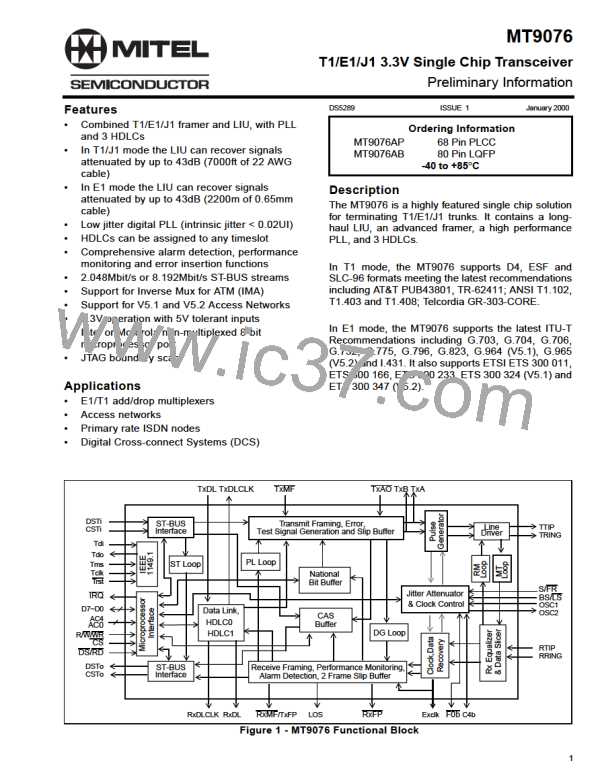Preliminary Information
MT9076
8.2.4
Frame Abort
The transmitter will abort a current packet by substituting a zero followed by seven contiguous 1s in place of the
normal packet. The receiver will abort upon reception of seven contiguous 1s occurring between the flags of a
packet which contains at least 26 bits.
Note that should the last received byte before the frame abort end with contiguous 1s, these are included in the
seven 1s required for a receiver abort. This means that the location of the abort sequence in the receiver may
occur before the location of the abort sequence in the originally transmitted packet. If this happens then the last
data written to the receive FIFO will not correspond exactly with the last byte sent before the frame abort.
8.2.5
Interframe Time Fill and Link Channel States
When the HDLC transmitter is not sending packets it will wait in one of two states
•
Interframe Time Fill state: This is a continuous series of flags occurring between frames indicating that
the channel is active but that no data is being sent.
•
•
Idle state: An idle Channel occurs when at least 15 contiguous 1s are transmitted or received.
In both states the transmitter will exit the wait state when data is loaded into the transmitter FIFO.
8.2.6
Go-Ahead
A go ahead is defined as the pattern "011111110" (contiguous 7Fs) and is the occurance of a frame abort
sequence followed by a zero, outside of the boundaries of a normal packet. Being able to distinguish a proper
(in packet) frame abort sequence from one occurring outside of a packet allows a higher level of signaling
protocol which is not part of the HDLC specifications.
8.3
HDLC Functional Description
The HDLC transceiver can be reset by either the power reset input signal or by the HRST Control bit in the test
control register (software reset). When reset, the HDLC Control Registers are cleared, resulting in the
transmitter and receiver being disabled. The Receiver and Transmitter can be enabled independent of one
another through Control Register 1. The transceiver input and output are enabled when the enable control bits
in Control Register 1 are set. Transmit to receive loopback as well as a receive to transmit loopback are also
supported. Transmit and receive bit rates and enables can operate independently. In MT9076 the transceiver
can operate at a continuous rate independent of RXcen and TXcen (free run mode) by setting the Frun bit of
Control Register 1.
Received packets from the serial interface are sectioned into bytes by an HDLC receiver that detects flags,
checks for go-ahead signals, removes inserted zeros, performs a cyclical redundancy check (CRC) on
incoming data, and monitors the address if required. Packet reception begins upon detection of an opening
flag. The resulting bytes are concatenated with two status bits (RQ9, RQ8) and placed in a receiver first-in-first-
out (Rx FIFO); a buffer register that generates status and interrupts for microprocessor read control.
In conjunction with the control circuitry, the microprocessor writes data bytes into a Tx buffer register (Tx FIFO)
that generates status and interrupts. Packet transmission begins when the microprocessor writes a byte to the
Tx FIFO. Two status bits are added to the Tx FIFO for transmitter control of frame aborts (FA) and end of
packet (EOP) flags. Packets have flags appended, zeros inserted, and a CRC, also referred to as frame
checking sequence (FCS), added automatically during serial transmission. When the Tx FIFO is empty and
finished sending a packet, Interframe Time Fill bytes (continuous flags (7E hex)), or Mark Idle (continuous
ones) are transmitted to indicate that the channel is idle.
8.3.1
HDLC Transmitter
Following initialization and enabling, the transmitter is in the Idle Channel state (Mark Idle), continuously
sending ones. Interframe Time Fill state (Flag Idle) is selected by setting the Mark idle bit in Control Register 1
high. The Transmitter remains in either of these two states until data is written to the Tx FIFO. Control Register
1 bits EOP (end of packet) and FA (Frame Abort) are set as status bits before the microprocessor loads 8 bits
of data into the 10 bit wide FIFO (8 bits data and 2 bits status). To change the tag bits being loaded in the FIFO,
Control Register 1 must be written to before writing to the FIFO. However, EOP and FA are reset after writing to
37

 MITEL [ MITEL NETWORKS CORPORATION ]
MITEL [ MITEL NETWORKS CORPORATION ]